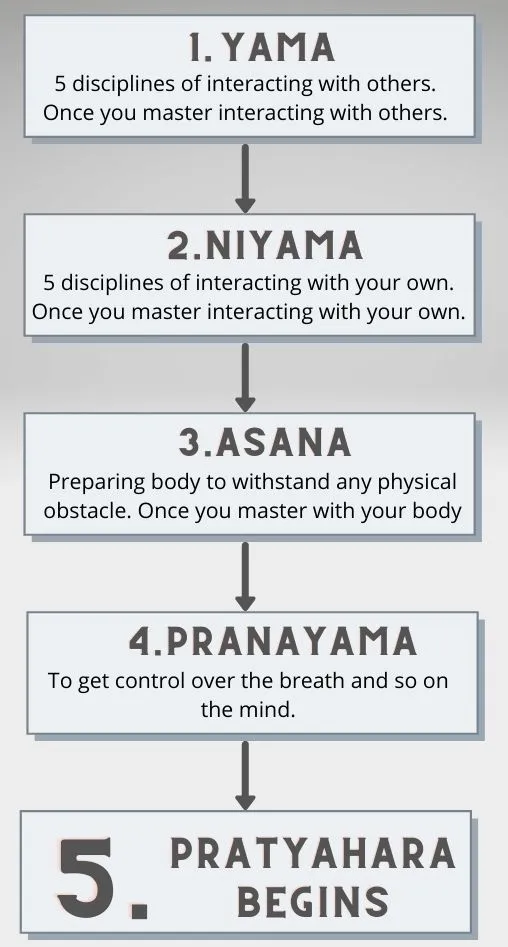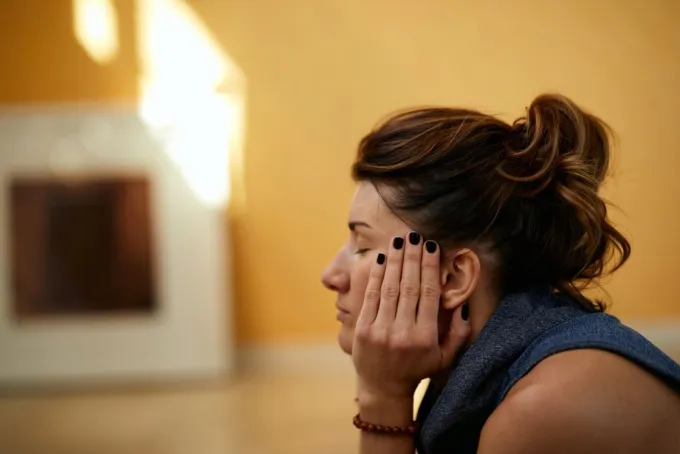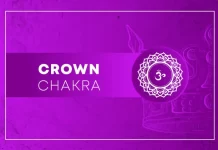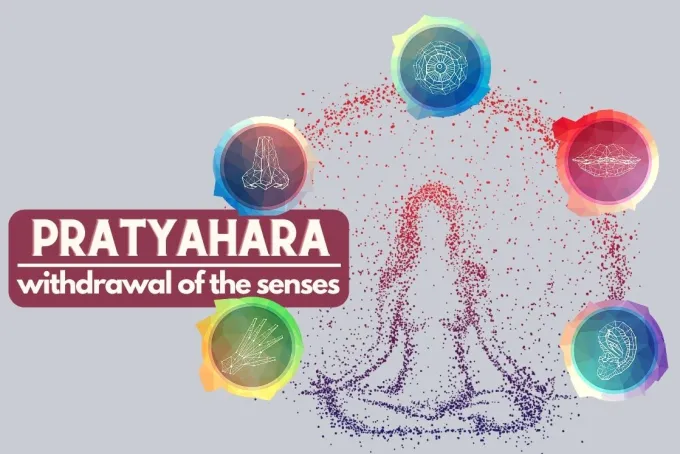Pratyahara is a meditation warm-up exercise where one learns to master their sense organs. According to yoga, there are 11 sense organs in the human body according to yoga; five of them are the Pancha Karmendriyas, five are the Pancha Jnanendriyas, and one is the manas.
As one of the 11 sense organs, the mind (or manas in yoga), meditation becomes a reasonably easy discipline after mastering Pratyahara.
Traditional Definition
In the 8 limbs of yoga, Pratyahara comes at the 5th step. In yoga sutras, it’s defined in chapter 2 – Sadhana Pada, after discussing the first four limbs Yama, Niayama, Asana & Pranayama.
In the above sutra, Maharishi Patanjali, the father of yoga, introduced the general idea of Pratyahara.
Pratyahara is when the senses (Endriyanam) withdraw (Asamprayoge) from the consumption of sensory objects (Svavisaya), only then (iv), do they turn inward and understand the nature of Chitta (Cittasya Svarupanukara)
After all, understanding the nature of Chitta is the ultimate aim of yogic practices.
Meaning
To understand what the term “Pratyahara” means, it can be broken down into 2 root terms;
Pratyahara → Prati + Ahara
- Prati means opposite
- Ahara means the food
In Pratyahara, Ahara (food) refers to what we ingest through our sense organs, i.e., objects in the Mundane world, and Prati (opposite) refers to a specific set of activities that should be avoided or “moved away from.”
Pratyahara essentially means to leave the mundane world’s consumption of sense organs.
Typically, our cognitive senses allow us to enjoy the commonplace world, and our action-taking organs allow us to react to it. Our cognitive senses, which include our eyes, ears, nose, mouth, and skin (Jnanendriyas), assist us in perceiving external objects, and we respond to what we perceive using Karmendriyas, which include our feet, hands, rectum, genitals, and mouth. It demonstrates how, under typical circumstances, our awareness is externalized.
However, in the Pratyahara practice, we see and respond to what is happening within us rather than exterior world happenings.
Pratyahara in Real World
It makes sense that since our inner environment is so calmer and richer than the outside one, we would wish to internalize the knowledge that typically goes outward.
You may have had this peace in your inner world when problems in the outside world kept upsetting you repeatedly, but when you closed your eyes for a time and disconnected from the outside world, everything seemed to be OK as if there had never been a problem.
The turtle is a prime illustration of this. Turtle immediately draws all of their limbs under their shell to protect themselves from danger when they sense any threat from the outside world. Stress, anxiety, despair, and other inputs from the outside world are what put us at risk as humans. While “our limbs” are the five senses we must bring inside to stay away from this threat.
Before Pratyahara Begins

The first four practices of yoga, Yama, Niyama, Asana, and Pranayama, are known as the Bahiranga Yoga, or exterior limbs of yoga, while the next four are known as Antaranga Yoga (internal limbs of yoga).
Pratyahara is a trip from the outside to the inside, connecting the two halves of a coin. The first four limbs of yoga should be practiced in order to physically and psychologically prepare the body for the practice of Pratyahara.

The final link in pranayama before starting pratyahara is known as kevala Kumbhaka.
In the Hatha Yoga practice of Pranayama, Kumbhaka is instructed to enter a condition of breath retention. There are two types;
- Sahita Kumbhaka – Stopping the breath in Pranayama with our own effort
- Kevala Kumbhaka – Automatic cessation of breath for as long as the practitioner wishes.
Natural pranayama is the condition of Kevala Kumbhaka, where you can effortlessly control your breathing.
Why does the practice of Pratyahara actually start once you have mastered Pranayama, or controlling your breath? Well, once the mind (or Chitta in yoga) is under control, we can effortlessly bring our awareness and outwardly flowing senses back to our inner selves.
Thus, when the breath is under control, the thought activity slows down, and in this state, it is simple and effortless to direct the sense organs inward. The Pratyahara, often known as “sensory withdrawal,” is this condition.
What Does “Sense Withdrawal” Really Mean?

In terms of Pratyahara, I used to think that “sense withdrawal” meant ceasing to use my senses to engage with the outside world. However, if you interpret it in this way, you will eventually come to the realization that practicing Pratyahara over the long term is impossible.
The fact that we live in a world where we are acutely aware of and frequently act upon what we see, hear, smell, taste, and touch isn’t the issue, of course. When you find it difficult to let go of the sensory pleasures—what we frequently act upon, what we see, hear, smell, taste, and touch—problems start to occur. The issue emerges when we begin to indulge in it and eventually forget the source from where it all originated.
“Sense withdrawal” in Pratyahara refers to maintaining a state of consciousness in which your cognitive senses and external attachments do not in any way irritate you. It implies that you should be fully in charge of your body, mind, and behaviors rather than letting them be controlled by outside forces or sensory inputs.
Here are some examples of Pratyahara in action when you have already withdrawn your senses from the outside world without even recognizing it:
- Imagine that your favorite food is in the room right now, and even though you can smell it, you don’t let the aroma distract you from your work.
- Sometimes when someone says something hurtful to you in a challenging scenario, you respond positively to the individual instead of responding back in kind.
- Imagine stumbling a little bit while walking on your toes. You had let go of this instead of responding to the sensory input of pain.
You were not actively driven by your senses in any of these scenarios; rather, you were unconsciously observing the demand of the moment and, since it was not very urgent, you had let the situation go. In Abhayasa, it is known as Pratyahara (process).
The Body and Mind In Pratyahara
What do we typically feed our bodies and minds all day? Pizza, hamburgers, coffee, social media, the news, the turmoil around us, advertisements, periodicals, and other things that appeal to our emotions and, consequently, our sense organs, drive us to want more and more. There is a great deal of metabolic activity and energy use.





















